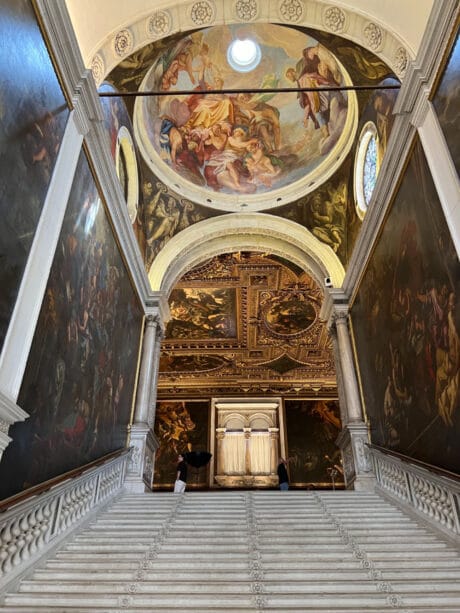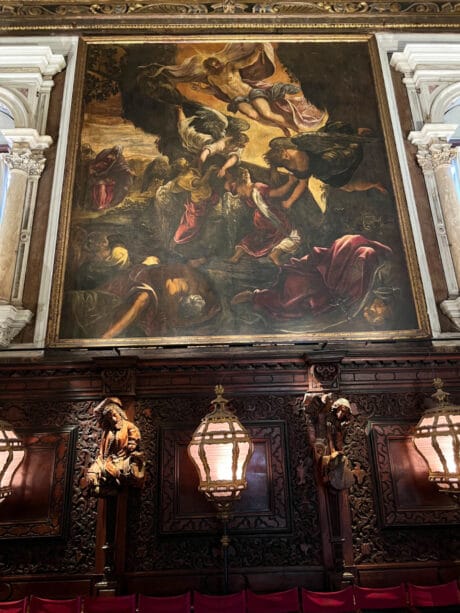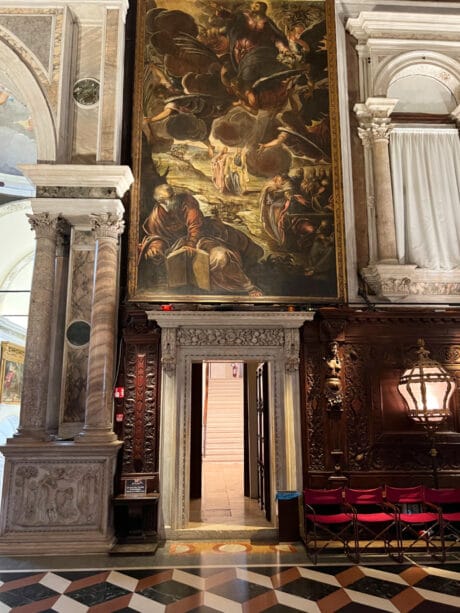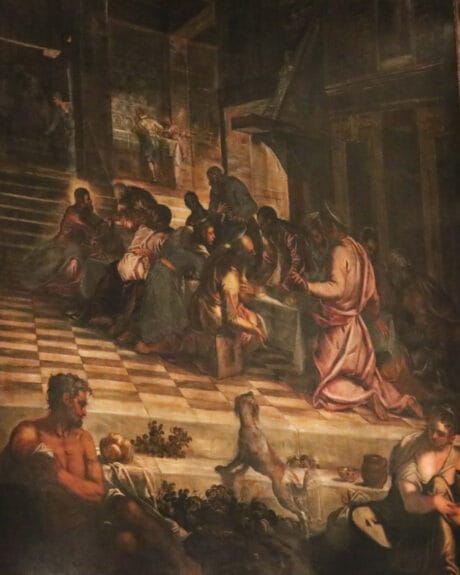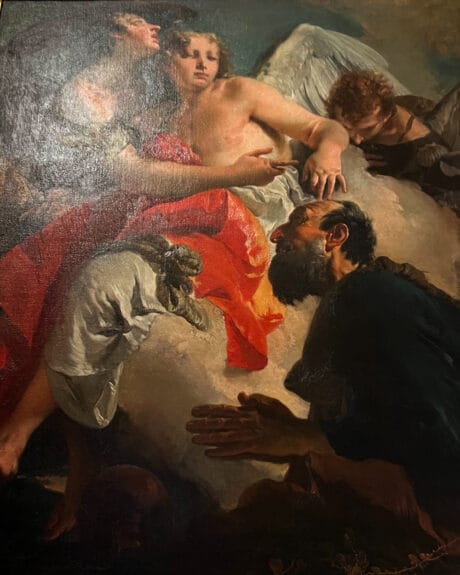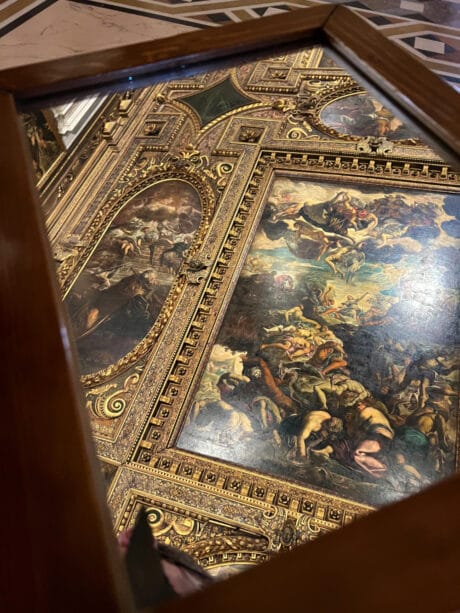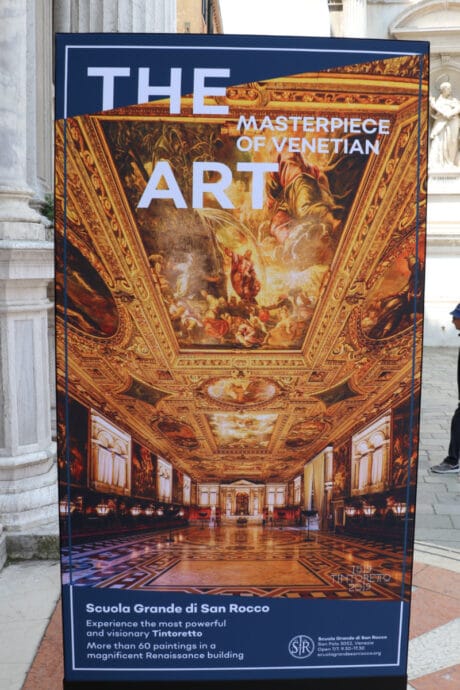The Scuola Grande di San Rocco, with its extraordinary cycle of more than 60 paintings by Jacopo Tintoretto, is one of the greatest art treasures in Venice.
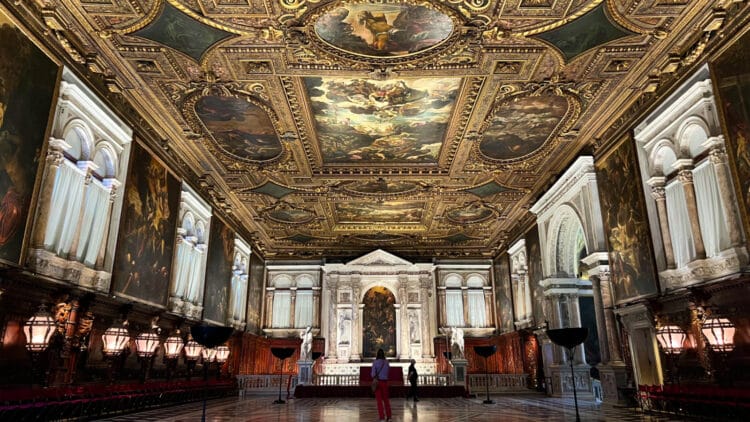
Over more than two decades, Tintoretto transformed the art and decorations of the Scuola Grande di San Rocco in Venice into a unified masterpiece, linking Old and New Testament scenes, the Passion of Christ, and Marian imagery into a seamless narrative.
Seen in their original Renaissance setting, the paintings immerse viewers in Tintoretto’s vision of faith and humanity. For the confraternity, they were moral lessons. For today’s visitors, they remain one of the most complete and moving artistic experiences in Europe. Admission tickets are only sold onsite, but entry is usually fast and without time-slot reservations.
Scuola Grande di San Rocco – Venice’s “Sistine Chapel”
The Scuola Grande di San Rocco is one of the greatest art treasures in Venice. It is celebrated above all for its extraordinary cycle of paintings by Jacopo Tintoretto.
Founded in 1478 as a confraternity dedicated to charitable works, the Scuola Grande di San Rocco was named after Saint Roch, the patron saint invoked against the plague. Like other Venetian scuole grandi, it was both a religious and civic centre, with grand halls for meetings and ceremonies.
The building, completed in 1560, is an impressive example of Venetian Renaissance architecture. Yet it is the art inside, especially Tintoretto’s vast biblical cycle, that makes the Scuola an essential stop for lovers of Venetian art.
Often called “the Sistine Chapel of Venice,” the Scuola surrounds visitors with monumental Renaissance masterpieces in their original setting.
Tintoretto’s Artistic Vision
In 1564, Jacopo Robusti, known as Tintoretto, 1519-1594, offered to decorate the Scuola for free, on the condition that he could choose the subjects himself. The confraternity agreed, and over the next two decades, he transformed the interior into one of the most ambitious decorative cycles in European art. (The exact arrangements changed a few times, but the Scuola generally got a very good deal.)
Rather than following the Bible in simple sequence, Tintoretto created a sweeping panorama that connects Old Testament prophecy, New Testament events, the Passion of Christ, and the life of the Virgin Mary. His paintings burst with energy, dramatic perspective, and radiant light breaking through deep shadow.
Seeing Tintoretto Paintings in the Scuola Grande di San Rocco
When visiting the Scuolo Grande de San Rocco, Tintoretto’s paintings are in three main rooms:
- Sala Terrena (Ground Floor) — visitors enter directly into this large space, which was used for services. The wall paintings here are the final works by Tintoretto, mostly depicting the life of the Virgin. These are best seen on the way out.
- Sala Capitolare (Large hall on the first floor) — the main room with ceiling and wall paintings illustrating various events from the Old and New Testaments.
- Sala Dell’Albergo (meeting room off the main hall) — this is where Tintoretto’s project started with The Crucifixion.
Fine works by other artists adorn the staircases, while a few smaller pieces in the Tesoro (treasury, located off the Sala Capitolare) are also worth seeing. Gilt ceilings and monumental decorations frame most of the paintings. Seen in the candlelit gloom of 16th‑century Venice, the effect must have been overwhelming.
Do pick up the free pamphlet with basic descriptions when visiting the museum. The works are not in chronological order, and some of the illustrated events may not be that familiar to current visitors, making it sometimes difficult to decipher the theme without guidance.
The Sala dell’Albergo – Passion and Redemption

Although the Sala dell’Albergo is deep inside the building, off the main hall on the second floor, this is a great place to start actively studying the paintings. Tintoretto’s two-decade working relationship with the Scuola started in this boardroom.
The centrepiece is the monumental Crucifixion, often considered the greatest Tintoretto painting in Venice. Rather than a static devotional scene, it’s alive with movement; soldiers hauling ladders, erecting two further crosses, women collapsing in grief, and bystanders caught in the chaos.

On the opposing wall are the Road to Calvary, Christ Before Pilate, and (above the door) Ecce Homo. Tintoretto also painted the ceiling paintings of allegorical figures, and in the center, St Roch in Glory.
(Tintoretto’s cycle on the Life of St Roch is in the adjacent Church.)
The Sala Superiore – Old and New Testament Drama

The Sala Superiore showcases Tintoretto’s mastery on a grand scale. Painted between 1575 and 1581, its walls feature monumental New Testament scenes, while the ceiling tells Old Testament stories. These works foreshadow Christ’s life and connect the two halves of the Bible in a unified vision.
Ceiling Paintings
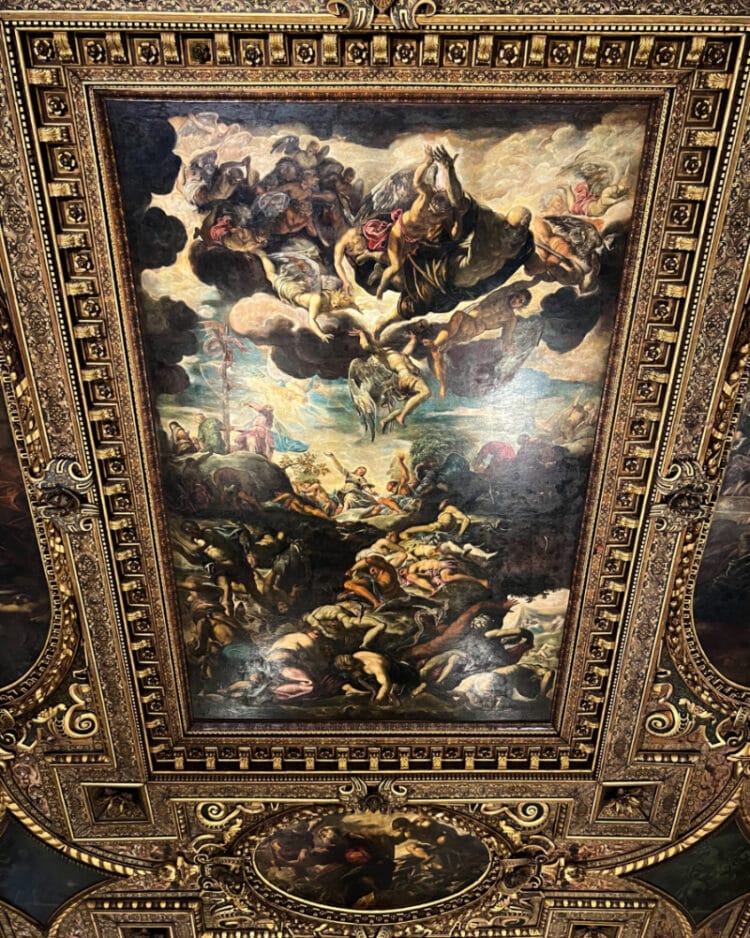
Some of the scenes, especially those from the Old Testament, are not necessarily the most famous or most frequently portrayed events. However, the three largest ceiling paintings fit well with the Scuola’s mission to provide aid and Venice’s frequent encounters with the plague:
The large center ceiling painting of The Erection of the Bronze Serpent (Numbers 21:4–9) depicts a dramatic Old Testament moment when God commanded Moses to raise a bronze serpent on a pole to heal those bitten by venomous snakes. Tintoretto fills the scene with writhing figures, urgent gestures, and a stark shaft of light striking the raised serpent. He chose the subject and placed it prominently in the Sala Superiore ceiling, to emphasise its role as a foreshadowing of Christ’s crucifixion, where looking to the cross brings salvation, just as the afflicted Israelites were healed by looking to the serpent.
For many modern Christians, the event is a bit pagan and almost the reverse of the Golden Calf incident, which is frequently portrayed in religious art. However, in a city often ravaged by the plague and disease, and at a time when relics were credited with healing powers, this probably resonated well. (The largest painting in the Galleria dell’Accademia by Tiepolo covers the same theme.)
The other two large ceiling paintings are also related to aid: providing fresh water (Moses Striking the Rock) and food (The Gathering of Manna).

The smaller, oval ceiling paintings include major themes such as Adam and Eve, Jacob’s Ladder, and the Sacrifice of Isaac, but also lesser-known events such as Jonah Leaves the Whale’s Belly and Elisha Multiplies the Loaves.
(Portable mirrors are available to prevent neck strain.)
Wall Paintings
The ten Tiepolo paintings on the wall are of more familiar New Testament scenes from the Life of Christ. The displays are not chronological, but some follow the themes of the nearby ceiling paintings, e.g,. The Last Supper and the Multiplication of the Loaves and Fishes are at the presbytery near the Manna ceiling painting.
Highlights include the Adoration of the Magi, set in a crumbling ruin lit by the glow of the Christ Child, and the Resurrection, where Christ ascends in dazzling light while soldiers scatter below.
Further art in the Sala Capitolare includes the reliefs on the cupboards in the presbytery and allegorical sculptures on the lower walls. Note the woodcarved panel of a bookcase between the sculptures of Fury and Curiosity.
Art on the Staircases and in the Tesoro

A staircase below The Ascension leads up to the small Tesoro (treasury) with the odd reliquary and trinkets.
Of more interest are a few paintings by famous artists:
- Giorgione: Christ Carrying the Cross
- Giovanni Battista Tiepolo: Hagar and Ishmael and Abraham and the Angels. (His son Giandomenico’s version, now in the Accademia, used the Apollo Belvedere as his nude angel model.)
- Vittore Belliniano: The Dead Christ.
- Titian: God the Father and Angels, but the best Titian is in the nearby Frari Church.

On the grand staircase, the two large paintings are about the plague, but the two smaller, older ones are of more artistic value:
- P. Negri: La Madonna salva Venezia dalla peste / The Virgin saving Venice from the plague, 1673
- A. Zanchi: La Vergine appare agli appestati / The Virgin appears to the plague victims, 1666
- Tiziano: L’Annunciazione / The Annunciation, 1535
- Tintoretto, La Visitazione / The Visitation, 1588
The Sala Terrena – The Life of the Virgin and the Early Church

The eight paintings on the ground‑floor Sala Terrena focus on the life of the Virgin Mary. Except for the Assumption, it is easy to identify all events from the standard Bible.
These were painted between 1583 and 1587. Tintoretto’s son and other assistants probably assisted more than on the upper floor.
One of its most moving works is the Annunciation. The Archangel Gabriel sweeps into a humble Venetian interior, robes swirling in a supernatural breeze. Mary, interrupted in her daily tasks, looks up in wonder as divine light fills the space.
The Flight into Egypt shows the Holy Family journeying under a dusky Venetian‑toned sky, both protected and vulnerable. These tender scenes, along with depictions of saints and Apostles, create a softer, more intimate atmosphere than the dramatic upstairs rooms.
Unity of the Decorative Cycle
The Scuola Grande di San Rocco is unique in that Tintoretto painted almost the entire decorative programme himself. Over more than twenty years, he kept a consistent style and linked Old and New Testament episodes, Passion scenes, and Marian imagery into a seamless narrative.
Even the gilded architectural frames form part of the composition, leading the viewer’s gaze from one image to the next. Seeing these works in their original Renaissance setting is a rare privilege—far more immersive than encountering them in a museum.
Light, Shadow, and Movement

Tintoretto’s art in the Scuola Grande di San Rocco shows his unmatched control of light, shadow, and motion. A single supernatural glow—a star, a vision, Christ himself—often becomes the heart of a painting. Darkness is alive with meaning, concealing and revealing details.
His figures rarely stand still. They bend, stride, or twist in complex poses that guide the viewer’s eye. Even in serene moments, there’s a feeling the story might suddenly leap to life.
Seen in the candlelit gloom of 16th‑century Venice, the effect must have been overwhelming.
An Encounter with Tintoretto’s Spiritual World

Visiting the Scuola is more than seeing paintings—it’s stepping into Tintoretto’s vision of faith and humanity. His biblical figures are grounded in Venetian life, dressed and posed like the people he knew, yet elevated to the realm of the divine.
For the confraternity, these works were moral lessons as much as decoration. For today’s traveller, it remains an unforgettable encounter with Venetian Renaissance art at its most passionate.
Few Renaissance art cycles survive complete and in situ. The Scuola Grande di San Rocco is one of the rare exceptions.
Visitor’s Information: Scuola Grande di San Rocco in Venice

Opening Hours and Tickets
The Scuola Grande di San Rocco is open daily from 9:30 to 17:30. It is only closed on December 25 and January 1.
The church is open the same hours, except opening only at 13:30 on Sunday.
Tickets for the Scuola Grande are €12. Discounted entry tickets are €10 for visitors over 70 years old or bearing a Rolling Venice Card, €3 for children 8 to 18, and free for children under 8.
Admission to the church of St Roch is €3.50.
Combination tickets add €2 to Scuola tickets for admission to both sites.
Tickets are only sold onsite and are without time-slot reservations. Entry is usually easy, even when the rest of Venice is jam-packed with tourists.
Transportation to the Scuola Grande di San Rocco in Venice
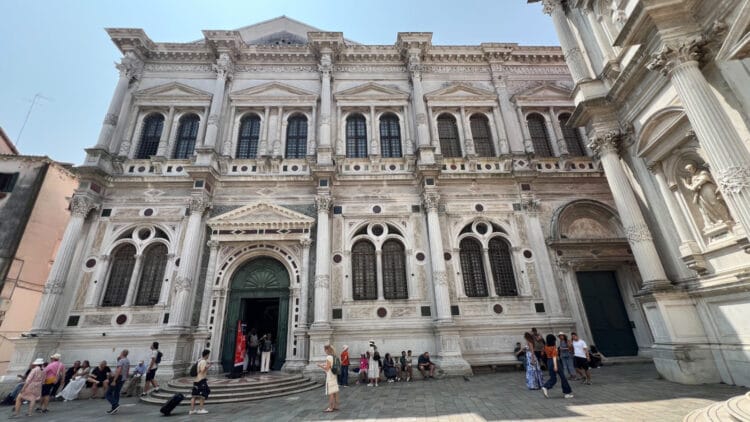
The Scuola Grande di San Rocco, Campo S. Rocco, 3052, 30125 Venezia VE, Italy, is behind the Frari Church, a few blocks off the Grand Canal, roughly halfway between the Galleria dell’Accademia and the train station. The closest vaporetto stop is S. Toma (lines 1 & 2) on the Grand Canal, with easy links to the station and San Marco Basilica.
Walking, if not getting lost, takes around 15 minutes from the station or Galleria dell’Accademia, and 20 minutes from San Marco (cross at Rialto).
